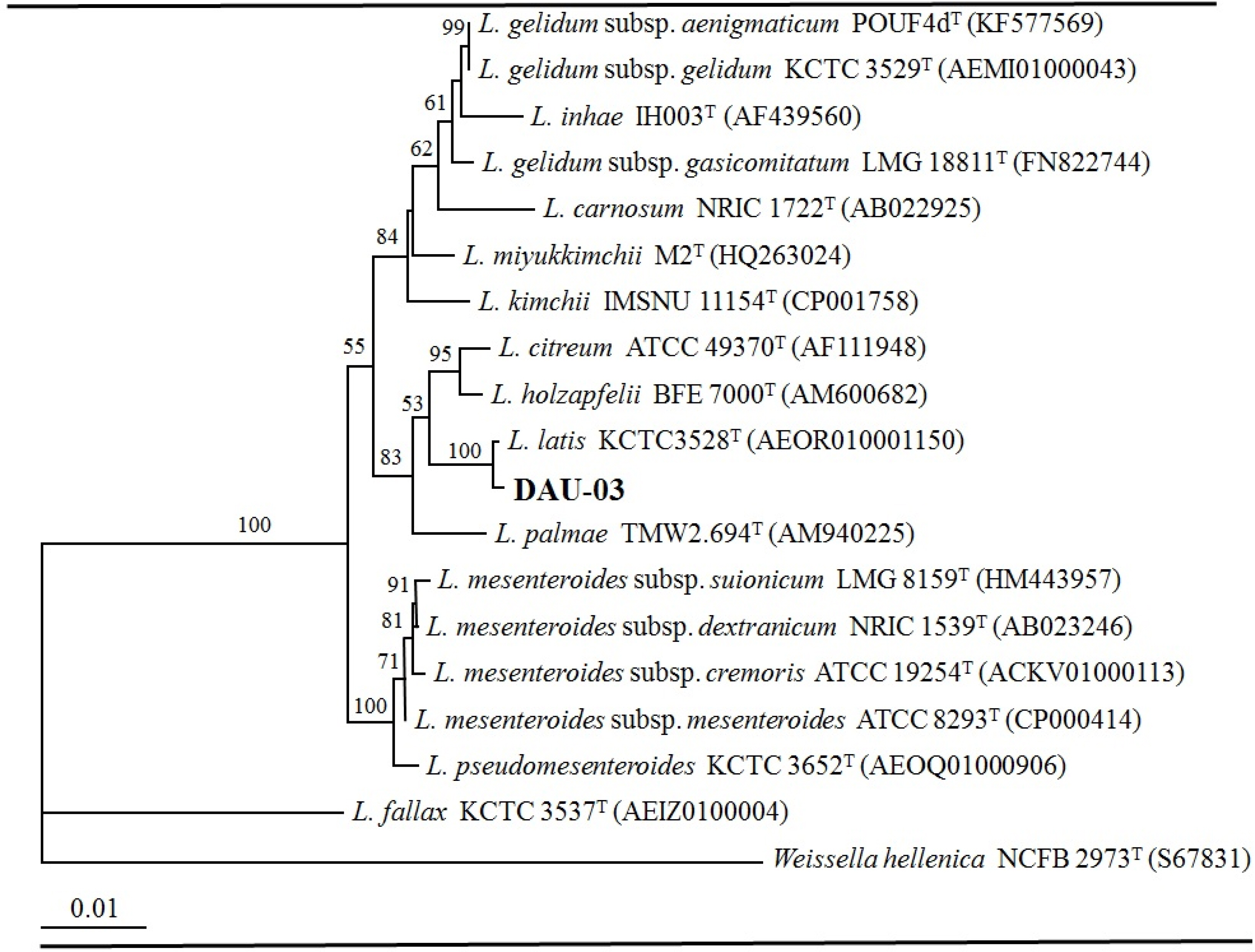Kosin Med J.
2018 Dec;33(3):422-430. 10.7180/kmj.2018.33.3.422.
Bacteremia caused by Leuconostoc species : 6-case series
- Affiliations
-
- 1Department of Internal Medicine, Dong-A University College of Medicine, Busan, Korea. dongsik72@hanmail.net
- 2Department of Molecular Cell Biology, Sungkyunkwan University College of Medicine, Suwon, Korea.
- KMID: 2442555
- DOI: http://doi.org/10.7180/kmj.2018.33.3.422
Abstract
- Leuconostoc species are Gram-positive coccobacilli and are used in dairy products and are intrinsically resistant to vancomycin. Leuconostoc infections are rare in humans, usually occurring in immune-compromised patients. We describe 6 patients with Leuconostoc bacteremia at Dong-A university hospital between 1990 and 2015. One isolate (L. lactis) was identified to species level using 16S rRNA gene sequencing analysis. All patients had underlying diseases and 5 patients underwent procedures that interrupted the normal integumentary defense. Four patients died within 30 days after being identified as carrying Leuconostoc species.
Keyword
MeSH Terms
Figure
Reference
-
1.Templin KS., Crook T., Riley T 3rd., Whitener C., Aber RC. Spontaneous bacterial peritonitis and bacteremia due to Leuconostoc species in a patient with end-stage liver disease; a case report. J Infect. 2001. 43:155–7.
Article2.Handwerger S., Horowitz H., Coburn K., Kolokathis A., Wormser G. Infection due to Leuconostoc species: six cases and review. Rev Infect Dis. 1990. 12:602–10.
Article3.Kim GY., Kim MH., Park SY., Park MJ., Suh JT., Lee HJ. A case of bacteremia caused by Leuconostoc lactis identified by 16S rRNA sequencing. Korean J Clin Microbiol. 2006. 9:137–41.4.Shin J., Her M., Moon C., Kim D., Lee S., Jung S. Leuconostoc bacteremia in a patient with amyloidosis secondary to rheumatoid arthritis and tuberculosis arthritis. Mod Rheumatol. 2011. 21:691–5.5.Shin KS., Han KD., Hong SB. Septicemia caused by Leuconostoc lactis with intrinsic toleranceto vancomycin in a patient with biliary stent. Korean Journal of Biomedical Laboratory Sciences. 2013. 19:280–3.6.Lee MR., Huang YT., Lee PI., Liao CH., Lai CC., Lee LN, et al. Healthcare-associated bacteremia caused by Leuconostoc species at a university hospital in Taiwan between 1995 and 2008. J Hosp Infect. 2011. 78:45–9.7.Moise-Broder PA., Sakoulas G., Eliopoulos GM., Schentag JJ., Forrest A., Moellering RC Jr. Accessory gene regulator group II polymorphism in methicillin-resistant Staphylococcus aureus is predictive of failure of vancomycin therapy. Clin Infect Dis. 2004. 38:1700–5.
Article8.Coovadia YM., Solwa Z., van Den Ende J. Potential pathogenicity of Leuconostoc. Lancet. 1988. 1:306.
Article9.Swenson JM., Facklam RR., Thornsberry C. Antimicrobial susceptibility of vancomycin- resistant Leuconostoc, Pediococcus, and Lactobacillus species. Antimicrob Agents Chemother. 1990. 34:543–9.10.Jordan JA., Durso MB. Comparison of 16S rRNA gene PCR and BACTEC 9240 for detection of neonatal bacteremia. J Clin Microbiol. 2000. 38:2574–8.
Article11.Sleigh J., Cursons R., Pine ML. Detection of bacteraemia in critically ill patients using 16S rDNA polymerase chain reaction and DNA sequencing. Intensive Care Med. 2001. 27:1269–73.
Article
- Full Text Links
- Actions
-
Cited
- CITED
-
- Close
- Share
- Similar articles
-
- A Case of Bacteremia Caused by Leuconostoc garlicum
- A Case of Bacteremia Caused by Leuconostoc lactis Identified by 16S rRNA Sequencing
- Two Cases of Bacteremia Caused by Leuconostoc citreum
- Two Cases of Leuconostoc Bacteremia
- Peritonitis Due to Leuconostoc Species in a Patient Receiving Continuous Ambulatory Peritoneal Dialysis


